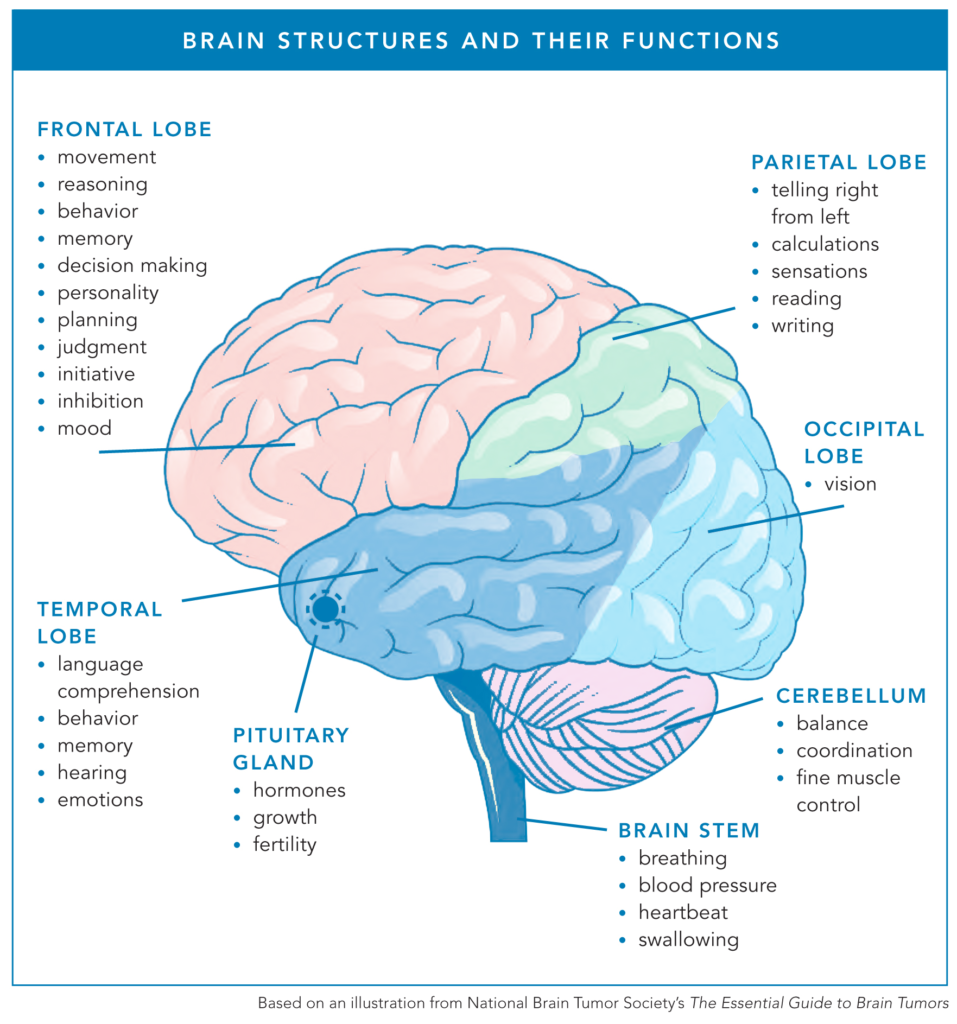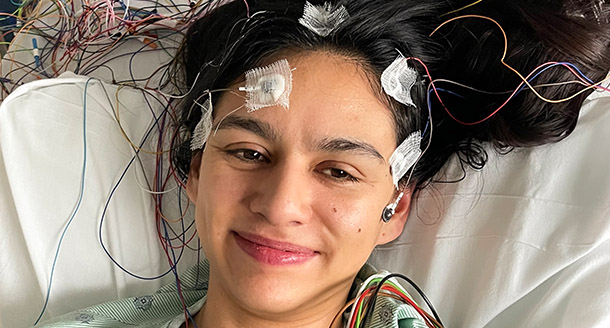When brain tumors are very small, some people may not experience any symptoms or the symptoms are so minimal they don’t notice them.
As brain tumors grow, signs and symptoms can vary and largely depend on the tumor’s location within the brain, its size, and how quickly it grows.
Some of the more common signs and symptoms caused by brain tumors include the following:
- Headaches
- Seizures
- Difficulty thinking, speaking, or finding words
- Changes in personality or behavior
- Weakness, numbness, or loss of movement in one part or one side of the body
- Difficulty with balance or dizziness
- Sensory changes like difficulty hearing, difficulty seeing, or loss of smell
- Memory loss
- Confusion in everyday matters or disorientation
- Unexplained nausea or vomiting
- Fatigue or muscle weakness
Other possible signs and symptoms can include abnormal eye movements, trouble swallowing, trouble walking, weakness or drooping of one side of the face, loss of appetite or weight loss, and slurred speech.
If you are experiencing any new, persistent, or concerning symptoms or you suspect you may have a brain tumor, please talk to your healthcare provider as soon as possible.
If you suddenly experience any of the following symptoms, please call 911:
- Numbness or weakness in the face, arm, or leg
- Trouble speaking or understanding speech
- Trouble seeing in one or both eyes
- Difficulty with walking, balance, or dizziness
- Worst headache of your life
While seizures may not require emergency medical attention, call 911 if one or more of the below are true:
- You have never experienced a seizure before
- The seizure lasts longer than 5 minutes
- Another seizure soon follows the first one
- A person has difficulty breathing or walking after the seizure
- A person is having a seizure in water
- The person has another health condition like diabetes, heart disease, or pregnancy
Areas of the Brain
Some people with brain tumors experience general symptoms like headaches, seizures, and fatigue. Other symptoms can be more specific to the location of the tumor in the brain.
Brain tumors can damage healthy tissue, press on healthy brain tissue, or cause pressure in the brain and negatively impact certain functions.
If you are diagnosed with a brain tumor, ask your provider where it is located in the brain to better prepare for possible symptoms and safety concerns.
Learn More About the Areas of the Brain
The cerebrum is the uppermost and largest part of the brain. It processes sensation, generates thought, and controls conscious activity. The cerebrum has two sides — the right and the left hemispheres that each control the opposite side of the body — and each side is divided into four lobes with specific functions: the frontal lobe, the parietal lobe, the temporal lobe, and the occipital lobe.
The frontal lobe is the part of the cerebrum that is located in the front of the brain. It is responsible for higher executive functions like regulating emotions, planning, reasoning, and problem-solving.
Symptoms of a tumor in the frontal lobe can include:
- Changes in personality, mood, or behavior
- Lack of inhibition or decreased impulse control
- Difficulty concentrating
- Agitation or aggression
- Sluggishness
- Weakness in one side of the body
- Loss of smell
- Trouble speaking (Broca’s area)
The parietal lobe is the part of the cerebrum that is located behind the frontal lobe. It is responsible for processing and interpreting sensory information like touch, temperature, pressure, and pain. It is also involved in telling the right from the left, navigation, language, and reading.
Symptoms of a tumor in the parietal lobe can include:
- Numbness or weakness in one side of the body
- Difficulty with spatial awareness and judging distances
- Loss of coordination including hand-eye coordination
- Trouble speaking, understanding words, reading, or writing
The temporal lobe is part of the cerebrum that is located on the side of the brain near the ears. It is responsible for hearing and understanding what we’re hearing, visual processing like recognizing people’s faces, and memory.
Symptoms of a tumor in the temporal lobe can include:
- Numbness or weakness in one side of the body
- Difficulty hearing or speaking
- Correctly identifying emotions in others
- Memory loss
- Strange sensations or smells
- Seizures
The occipital lobe is part of the cerebrum that is located at the back of the brain. It is responsible for sight and activities like reading and recognizing colors.
Symptoms of a tumor in the occipital lobe can include:
- Loss of vision
- Difficulty identifying objects
There are five additional areas that can be affected by the location of the tumor.
The cerebellum is located at the back part of the brain near the bottom of the head. It is mainly responsible for balance, coordination, movement, and fine motor skills.
Symptoms of a tumor in the cerebellum can include:
- Difficulty walking (ataxia)
- Uncoordinated muscle movements
- Loss of fine motor skills
- Headache
- Vomiting
- Dizziness or loss of balance
The brainstem is the part of the brain that connects to the spinal cord and the cerebellum. It controls involuntary and essential functions such as breathing and the beating of the heart.
Symptoms of a tumor in the brain stem can include:
- Seizures
- Unsteadiness and difficulty walking
- Loss of movement in the muscles in the face
- Difficulty speaking
- Difficulty swallowing
- Double vision
- Changes in breathing
The spinal cord is a long column of nerve tissue that begins at the end of the brain stem and down the center of the spine. It allows for movement, feeling sensation, and control of different functions in the body.
Tumors in the spinal cord can impact the nerves, blood vessels, and bones of the spine. Symptoms can include:
- Local pain at the site of the tumor
- Back pain that radiates to other parts of the body
- Loss of sensitivity to pain, heat, or cold
- Loss of bladder or bowel function (incontinence)
- Difficulty walking
- Loss of sensation or muscle weakness in the arms or legs
The meninges are three layers of tissue that surround and protect the brain and the spinal cord. The meninges provide a support system and protect the nervous system from injury.
Symptoms of a tumor of the meninges can include:
- Headache
- Dizziness
- Nausea and vomiting
- Changes in vision or bulging of the eyes
- Loss of smell
- Hearing loss
- Seizures
- Overactive reflexes
- Muscle weakness in certain areas of the body
- Paralysis in certain areas of the body
While not technically part of the brain, the pituitary gland is located at the base of the brain. It secretes hormones and helps regulate many processes in the body like growth, metabolism, and reproduction.
Tumors in the pituitary gland can cause symptoms that include:
- Headache
- Vision loss
- Increase or decrease in hormone production that lead to changes like weight loss or gain, sexual dysfunction, feeling cold, excessive sweating, and more
Additional Resources
Managing Symptoms through Palliative Care
National Brain Tumor Society’s Symptom Tracker
National Cancer Institute’s My STORITM Symptom Tracking App
American Society of Clinical Oncology’s Cancer.Net Mobile App




